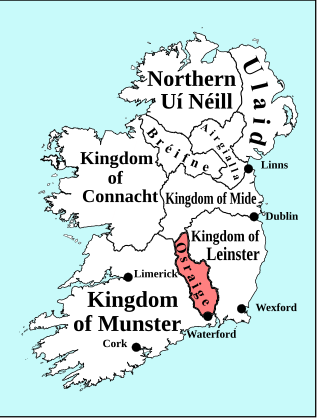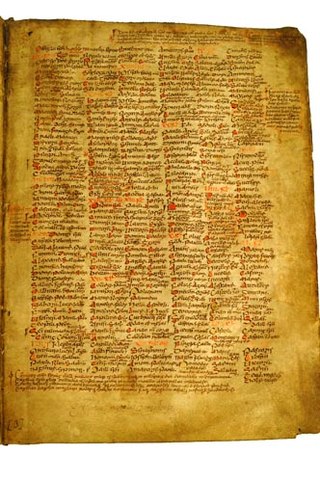Related Research Articles
Dubhaltach Mac Fhirbhisigh, also known as Dubhaltach Óg mac Giolla Íosa Mór mac Dubhaltach Mór Mac Fhirbhisigh, Duald Mac Firbis, Dudly Ferbisie, and Dualdus Firbissius was an Irish scribe, translator, historian and genealogist. He was one of the last traditionally trained Irish Gaelic scholars, and was a member of the Clan MacFhirbhisigh, a leading family of northern Connacht. His best-known work is the Leabhar na nGenealach, which was published in 2004 as The Great Book of Irish Genealogies, by Éamonn de Búrca, more than 300 years after it had been written.

The Book of Leinster is a medieval Irish manuscript compiled c. 1160 and now kept in Trinity College Dublin, under the shelfmark MS H 2.18. It was formerly known as the Lebor na Nuachongbála "Book of Nuachongbáil", a monastic site known today as Oughaval.

The kings of Osraige reigned over the medieval Irish kingdom of Osraige from the first or second century AD until the late twelfth century. Osraige was a semi-provincial kingdom in south-east Ireland which disappeared following the Norman Invasion of Ireland. A number of important royal Ossorian genealogies are preserved, particularly MS Rawlinson B502, which traces the medieval Mac Giolla Phádraig dynasty back through Óengus Osrithe, who supposedly flourished in the first or second century. and one in the Book of Leinster. Recent analysis of ninth and tenth century regnal succession in Osraige has suggested that in peaceful times, kingship passed primarily from eldest to youngest brother, before crossing generations and passing to sons and nephews.

Saint Ruain Burrows was founder and abbot-bishop of the monastery of Tallaght. He is often considered to be a leading figure of the monastic 'movement' that has become known to scholarship as the Céli Dé. He is not to be confused with the later namesake Máel Ruain, bishop of Lusca.

Secundinus, or Sechnall as he was known in Irish, was founder and patron saint of Domhnach Sechnaill, Co. Meath, who went down in medieval tradition as a disciple of St Patrick and one of the first bishops of Armagh. Historians have suggested, however, that the connection with St Patrick was a later tradition invented by Armagh historians in favour of their patron saint and that Secundinus is more likely to have been a separate missionary, possibly a companion of Palladius.
The Yellow Book of Lecan, or TCD MS 1318, is a late medieval Irish manuscript. It contains much of the Ulster Cycle of Irish mythology, besides other material. It is held in the Library of Trinity College Dublin.
Fled Bricrenn is a story from the Ulster Cycle of Irish mythology. Bricriu, an inveterate troublemaker, invites the nobles of the Ulaid to a feast at his new bruiden at Dún Rudraige, where he incites three heroes, Cúchulainn, Conall Cernach, and Lóegaire Búadach, to compete for the "champion's portion" of the feast. The three heroes perform several feats, and travel to Connacht to be judged by Ailill and Medb, and to Munster to be judged by Cú Roí, and on each occasion Cúchulainn is proclaimed champion, but the other two refuse to accept it. Eventually, back at Emain Macha, the three heroes are each challenged by a giant churl to cut off his head, on the condition that they allow him to cut off their heads in return. First Lóegaire, then Conall, takes up the challenge and cuts off the churl's head, only for him to pick it up and leave, but when the churl returns the following night they are nowhere to be seen. Only Cúchulainn lives up to his side of the bargain. The churl spares his life, reveals himself to be Cú Roí in disguise, and announces that Cúchulainn's bravery and honour make him undisputed champion.
William Reeves was an Irish antiquarian and the Church of Ireland Bishop of Down, Connor and Dromore from 1886 until his death. He was the last private keeper of the Book of Armagh and at the time of his death was President of the Royal Irish Academy.
Oxford, Bodleian Library, Rawlinson B 502 is a medieval Irish manuscript which presently resides in the Bodleian Library, Oxford. It ranks as one of the three major surviving Irish manuscripts to have been produced in pre-Norman Ireland, the two other works being the Lebor na hUidre and the Book of Leinster. Some scholars have also called it the Book of Glendalough, in Irish Lebar Glinne Dá Locha, after several allusions in medieval and early modern sources to a manuscript of that name. However, there is currently no agreement as to whether Rawlinson B 502, more precisely its second part, is to be identified as the manuscript referred to by that title.
The Tale of Mac Da Thó's Pig is a legendary tale in the Ulster Cycle.
The Stowe manuscripts are a collection of about two thousand Irish, Anglo-Saxon and later medieval manuscripts, nearly all now in the British Library. The manuscripts date from 1154 to the end of the 14th century.
Annla Gearra as Proibhinse Ard Macha, in English The Short Annals of Armagh, is an Irish text contained in British Library, Add MS 30512, compiled c. 1460–75.
The Short Annals of Tirconaill is an Irish annal, or annual record, with entries dating from 1241 to 1650, but with numerous gaps, such as 1241 to 1423. Its authors are unknown; historian Paul Walsh speculated that it had several scribes over the course of some four hundred years, ending in 1650 or the years immediately after.
Memoranda Gadelica aka Dublin, Trinity College MS H. 4. 31, is an Irish annal, covering the years 1582 to 1665.
Leabhar Oiris is a Gaelic-Irish manuscript and chronicle.
Scéla Conchobair maic Nessa or the Tidings of Conchobar mac Nessa is a title invented by Whitley Stokes for a short prose piece from the Ulster Cycle preserved in the 12th-century manuscript, the Book of Leinster. It is interpolated with lore not found elsewhere regarding the branches (halls) of the Ulster court at Emain Macha and the shields of the Ulstermen.
Loígis is the name of an Irish tribe, as it is called by contemporary scholars. Formerly, scholars generally called the tribe Laoighis or Laeighis in Irish, Lagisia in Latin, and Leix in English. Loígis is also the name of the territory in western Leinster that the tribe settled during the third century AD, and of the minor kingdom that the Loígis chieftains ruled until 1608. County Laois derives its name from Loígis, although the present county encompasses baronies that were not traditionally part of the territory of Loígis.
Énna Mac Murchada, or Enna Mac Murchada, also known as Énna mac Donnchada, and Énna mac Donnchada mic Murchada, was a twelfth-century ruler of Uí Chennselaig, Leinster, and Dublin. Énna was a member of the Meic Murchada, a branch of the Uí Chennselaig dynasty that came to power in Leinster in the person of his paternal great-grandfather. Énna himself gained power following the death of his cousin Diarmait mac Énna. Throughout much of his reign, Énna acknowledged the overlordship of Toirdelbach Ua Conchobair, King of Connacht, although he participated in a failed revolt against the latter in 1124 before making amends. When Énna died in 1126, Toirdelbach successfully took advantage of the resulting power vacuum.
Domnall mac Murchada, also known as Domnall mac Murchada meic Diarmata, was a leading late eleventh-century claimant to the Kingdom of Leinster, and a King of Dublin. As a son of Murchad mac Diarmata, King of Dublin and the Isles, Domnall was a grandson of Diarmait mac Máel na mBó, King of Leinster, and thus a member of the Uí Chennselaig. Domnall was also the first of the Meic Murchada, a branch of the Uí Chennselaig named after his father.
References
- Dublin, Trinity College MS H. 4. 31, ff. 98, 103. For further details see T. K. Abbott and E. J. Gwynn (eds.), Catalogue of the Irish manuscripts in the library of Trinity College, Dublin (Dublin, 1921), entry 1372, p. 223.
- Dublin, Trinity College MS H. 4. 25, ff. 190–1. For further details see Catalogue of the Irish manuscripts in the library of Trinity College, Dublin, entry 1366, p. 220.
- Pól Breathnach, Short Annals of Leinster, in Irish Book Lover 24 (Dublin 1936) pp. 58–60.
- Eugene O'Curry, Lectures on the manuscript materials of ancient Irish history (Dublin 1861; repr. Dublin, 1878 and 1995).
- Paul Walsh, The dating of Irish annals, in Irish Historical Studies 2 (1941), pp. 355–75.
- Gearóid Mac Niocaill, The medieval Irish annals (Dublin: DIAS, 1975).
- Daniel P. Mc Carthy, The Irish Annals: their genesis, evolution and history (Dublin 2008).